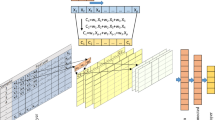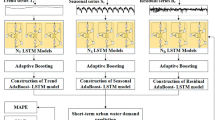Abstract
Accurate prediction of water demand in a city is crucial for the management of urban water distribution system. The current study aims to create adequate daily water demand forecasting models for the Canadian metropolis of London utilizing deep learning (DL)-based models. This study explores the potential of two stand-alone DL models for daily water demand modeling using a convolutional neural network (CNN) and the long short-term memory (LSTM) along with their hybrid CNN–LSTM model. Furthermore, a deep learning-based bi-directional LSTM model is introduced with CNN to predict daily water consumption in London as CNN–BiLSTM hybrid model. Daily water consumption data for the years 2009 to 2020 are used for the development and assessment of the predictive models. These stand-alone and hybrid models have been developed with specified input lags of daily water demand and verified for daily water demand prediction. The performance of the developed hybrid models was compared with other well-established DL-based stand-alone models. The model outcomes during the training, validation, and testing phases were assessed using statistical metrics such as the mean absolute error (MAE), Nash–Sutcliffe coefficient (NSE), correlation coefficient (r), Scatter Index (SI), Mean Bias Error (MBE), and Discrepancy Ratio (DR). The stand-alone models captured the observations very well during training and testing which is obvious at 1-day ahead. Moreover, at 7 days and 15 days ahead those models, except the stand-alone CNN, closely reproduced the pattern in daily water demand. Among the hybrid models, the outperforming CNN–BiLSTM model produced 1-day to 15-day multi-step ahead forecasting with performance metrics in the following ranges: MAE = 0.245–2.541 ML/day, NSE = 99.830–84.843% and r = 0.999–0.921 during the testing period. The uncertainty analysis has been performed which advocates the superiority of the CNN–BiLSTM model showing the forecasts bands with 88–90% observations within the 90% confidence interval (CI). Overall, the outcomes supporting the CNN–BiLSTM is to be considered as a promising deep learning procedure for accurate forecasting of urban water demand in any city globally.












Similar content being viewed by others
Data Availability
Upon reasonable request, the corresponding author will provide access to all the data and codes that support the findings of this study.
References
Nasseri M, Moeini A, Tabesh M. Forecasting monthly urban water demand using extended Kalman filter and genetic programming. Expert Syst Appl. 2011;38(6):7387–95.
Walker D, et al. Forecasting domestic water consumption from smart meter readings using statistical methods and artificial neural networks. Procedia Eng. 2015;119:1419–28.
Zhou S, et al. Forecasting operational demand for an urban water supply zone. J Hydrol. 2002;259(1–4):189–202.
Li W, Huicheng Z. Urban water demand forecasting based on HP filter and fuzzy neural network. J Hydroinf. 2010;12(2):172–84.
Ghiassi M, Zimbra DK, Saidane H. Urban water demand forecasting with a dynamic artificial neural network model. J Water Resour Plan Manag. 2008;134(2):138–46.
Jain A, Varshney AK, Joshi UC. Short-term water demand forecast modelling at IIT Kanpur using artificial neural networks. Water Resour Manag. 2001;15(5):299–321.
Adamowski JF. Peak daily water demand forecast modeling using artificial neural networks. J Water Resour Plan Manag. 2008;134(2):119–28.
Gato S, Jayasuriya N, Roberts P. Forecasting residential water demand: case study. J Water Resour Plan Manag. 2007;133(4):309–19.
Gato S, Jayasuriya N, Roberts P. Temperature and rainfall thresholds for base use urban water demand modelling. J Hydrol. 2007;337(3–4):364–76.
Shabani S, et al. Intelligent soft computing models in water demand forecasting. In: Water Stress in Plants. Croatia: InTech; 2016. p. 99–117.
Kofinas D, et al. Urban water demand forecasting for the island of Skiathos. Procedia Eng. 2014;89:1023–30.
Hu P, et al. A hybrid model based on CNN and Bi-LSTM for urban water demand prediction. In: 2019 IEEE congress on evolutionary computation (CEC). IEEE; 2019.
Braun M, et al. 24-hours demand forecasting based on SARIMA and support vector machines. Procedia Eng. 2014;89:926–33.
Brentan BM, et al. Hybrid regression model for near real-time urban water demand forecasting. J Comput Appl Math. 2017;309:532–41.
Herrera M, et al. Predictive models for forecasting hourly urban water demand. J Hydrol. 2010;387(1–2):141–50.
Msiza IS, Nelwamondo FV, Marwala T. Artificial neural networks and support vector machines for water demand time series forecasting. In: 2007 IEEE international conference on systems, man and cybernetics.IEEE; 2007.
Mouatadid S, Adamowski J. Using extreme learning machines for short-term urban water demand forecasting. Urban Water J. 2017;14(6):630–8.
Tiwari M, Adamowski J, Adamowski K. Water demand forecasting using extreme learning machines. J Water Land Dev. 2016;28:37–52.
Qi C, Chang N-B. System dynamics modeling for municipal water demand estimation in an urban region under uncertain economic impacts. J Environ Manag. 2011;92(6):1628–41.
Tiwari MK, Adamowski JF. Medium-term urban water demand forecasting with limited data using an ensemble wavelet–bootstrap machine-learning approach. J Water Resour Plan Manag. 2015;141(2):04014053.
Zubaidi SL, et al. A Novel approach for predicting monthly water demand by combining singular spectrum analysis with neural networks. J Hydrol. 2018;561:136–45.
Zubaidi SL, et al. A novel methodology for prediction urban water demand by wavelet denoising and adaptive neuro-fuzzy inference system approach. Water. 2020;12(6):1628.
Kumar D, et al. Forecasting monthly precipitation using sequential modelling. Hydrol Sci J. 2019;64(6):690–700.
Zhang L, Wang S, Liu B. Deep learning for sentiment analysis: a survey. Wiley Interdiscip Rev Data Min Knowl Discov. 2018;8(4): e1253.
Tang D, Qin B, Liu T. Deep learning for sentiment analysis: successful approaches and future challenges. Wiley Interdiscip Rev Data Min Knowl Discov. 2015;5(6):292–303.
Balaban S. Deep learning and face recognition: the state of the art. In: Biometric and surveillance technology for human and activity identification XII. International Society for Optics and Photonics; 2015
Parkhi OM, Vedaldi A, Zisserman A. Deep face recognition. In: Proceedings of the British machine vision conference (BMVC). 2015.
Young T, et al. Recent trends in deep learning based natural language processing. IEEE Comput Intell Mag. 2018;13(3):55–75.
Salman AG, Kanigoro B, Heryadi Y. Weather forecasting using deep learning techniques. In: 2015 International conference on advanced computer science and information systems (ICACSIS). IEEE; 2015.
Gamboa JCB. Deep learning for time-series analysis. arXiv preprint arXiv:1701.01887 (2017)
LeCun Y, Bengio Y, Hinton G. Deep learning. Nature. 2015;521(7553):436–44.
Chen Y, et al. Deep feature extraction and classification of hyperspectral images based on convolutional neural networks. IEEE Trans Geosci Remote Sens. 2016;54(10):6232–51.
Guo G, et al. Short-term water demand forecast based on deep learning method. J Water Resour Plan Manag. 2018;144(12):04018076.
Salloom T, Kaynak O, He W. A novel deep neural network architecture for real-time water demand forecasting. J Hydrol. 2021;599: 126353.
Du B, et al. Deep learning with long short-term memory neural networks combining wavelet transform and principal component analysis for daily urban water demand forecasting. Expert Syst Appl. 2021;171: 114571.
Xu Y, et al. A novel dual-scale deep belief network method for daily urban water demand forecasting. Energies. 2018;11(5):1068.
Xu Y, et al. Hourly urban water demand forecasting using the continuous deep belief echo state network. Water. 2019;11(2):351.
Kim J, et al. Development of a deep learning-based prediction model for water consumption at the household level. Water. 2022;14(9):1512.
Kavya M, et al. Short term water demand forecast modelling using artificial intelligence for smart water management. Sustain Cities Soc. 2023;95: 104610.
Shahid F, Zameer A, Muneeb M. Predictions for COVID-19 with deep learning models of LSTM, GRU and Bi-LSTM. Chaos Solitons Fract. 2020;140: 110212.
McCulloch WS, Pitts W. A logical calculus of the ideas immanent in nervous activity. Bull Math Biophys. 1943;5(4):115–33.
Rumelhart D, Hinton G, Williams R. Learning internal representations by error propagation. In: Rumelhart DE, McClelland JL, editors. Parallel distributed processing. Cambridge: MIT Press; 1986.
Caudill M, Butler C. Understanding neural networks; computer explorations. Cambridge: MIT Press; 1992.
Schmidhuber J. Deep learning in neural networks: an overview. Neural Netw. 2015;61:85–117.
Pascanu R, Mikolov T, Bengio Y (2013) On the difficulty of training recurrent neural networks. In: International conference on machine learning. PMLR; 2013.
Kag A, Zhang Z, Saligrama V. RNNS incrementally evolving on an equilibrium manifold: a panacea for vanishing and exploding gradients? In: International Conference on Learning representations. 2019.
Hochreiter S, Schmidhuber J. Long short-term memory. Neural Comput. 1997;9(8):1735–80.
Krizhevsky A, Sutskever I, Hinton GE. Imagenet classification with deep convolutional neural networks. Adv Neural Inf Process Syst. 2012;25:1097–105.
Chaerun Nisa E, Kuan Y-D. Comparative assessment to predict and forecast water-cooled chiller power consumption using machine learning and deep learning algorithms. Sustainability. 2021;13(2):744.
Graves A, Schmidhuber J. Framewise phoneme classification with bidirectional LSTM and other neural network architectures. Neural Netw. 2005;18(5–6):602–10.
Chollet F. Keras: Deep learning library for theano and tensorflow, vol. 7, no. 8, p. T1. 2015. https://keras.io/k.
Shamshirband S, et al. Predicting standardized streamflow index for hydrological drought using machine learning models. Eng Appl Comput Fluid Mech. 2020;14(1):339–50.
Sattari MT, et al. Potential of kernel and tree-based machine-learning models for estimating missing data of rainfall. Eng Appl Comput Fluid Mech. 2020;14(1):1078–94.
Saberi-Movahed F, Najafzadeh M, Mehrpooya A. Receiving more accurate predictions for longitudinal dispersion coefficients in water pipelines: training group method of data handling using extreme learning machine conceptions. Water Resour Manag. 2020;34(2):529–61.
Jeong DI, Kim YO. Rainfall-runoff models using artificial neural networks for ensemble streamflow prediction. Hydrol Process Int J. 2005;19(19):3819–35.
Weerts A, Winsemius H, Verkade J. Estimation of predictive hydrological uncertainty using quantile regression: examples from the National Flood Forecasting System (England and Wales). Hydrol Earth Syst Sci. 2011;15(1):255–65.
Fuller WA. Introduction to statistical time series. New York: Wiley; 1976.
Amiri-Ardakani Y, Najafzadeh M. Pipe break rate assessment while considering physical and operational factors: a methodology based on global positioning system and data-driven techniques. Water Resour Manag. 2021;35(11):3703–20.
Tiwari MK, Adamowski J. Urban water demand forecasting and uncertainty assessment using ensemble wavelet-bootstrap-neural network models. Water Resour Res. 2013;49(10):6486–507.
Yong L, Jiahong L. A distributed model for urban water demand prediction. Chin Sci Bull. 2017;62(24):2770–9.
Huayi L, et al. Research and application of urban water demand forecasting based on time difference coefficient. J Shanghai Jiaotong Univ (Chin Ed). 2017;51(10):1260.
Acknowledgements
The authors would like to acknowledge Municipal Artificial Intelligence application lab out of the Information Technology Services division, London, Canada for sharing data.
Author information
Authors and Affiliations
Corresponding author
Ethics declarations
Conflict of Interest
The authors affirm that they have no conflicts of interest to disclose.
Additional information
Publisher's Note
Springer Nature remains neutral with regard to jurisdictional claims in published maps and institutional affiliations.
Rights and permissions
Springer Nature or its licensor (e.g. a society or other partner) holds exclusive rights to this article under a publishing agreement with the author(s) or other rightsholder(s); author self-archiving of the accepted manuscript version of this article is solely governed by the terms of such publishing agreement and applicable law.
About this article
Cite this article
Sahoo, B.B., Panigrahi, B., Nanda, T. et al. Multi-step Ahead Urban Water Demand Forecasting Using Deep Learning Models. SN COMPUT. SCI. 4, 752 (2023). https://doi.org/10.1007/s42979-023-02246-6
Received:
Accepted:
Published:
DOI: https://doi.org/10.1007/s42979-023-02246-6




